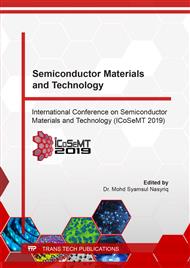[1]
Zhuo, H., Hu, J., Chen, S., & Yeung, L. (2008). Preparation of polyurethane nanofibers by electrospinning. Journal of Applied Polymer Science, 109(1), 406-411.
DOI: 10.1002/app.28067
Google Scholar
[2]
H. Zhu, C.C. Lin, W. Luo, S. Shu, Z. Liu, Y. Liu, J. Kong, E. Ma, Y. Cao, R.S. Liu, X. Chen, Highly efficient non-rare-earth red-emitting phosphor for warm white light-emitting diodes, Nat. Commun. 5 (2014) (4312-4312).
DOI: 10.1038/ncomms5312
Google Scholar
[3]
G. Li, Y. Zhang, D. Geng, M. Shang, C. Peng, Z. Cheng, J. Lin, Single-composition trichromatic white-emitting Ca4Y6(SiO4)6O: Ce3+/Mn2+/Tb3+ phosphor: luminescence and energy transfer, ACS Appl. Mater. Interfaces 4 (2012) 296–305.
DOI: 10.1021/am201335d
Google Scholar
[4]
J. Liu, X. Wang, T. Xuan, C. Wang, H. Li, Z. Sun, Lu3(Al, Si)5(O, N)12: Ce3+ phosphors with broad emission band and high thermal stability for white LEDs, J. Lumin. 158 (2015) 322–327.
DOI: 10.1016/j.jlumin.2014.10.032
Google Scholar
[5]
X. Wang, G. Zhou, H. Zhang, H. Li, Z. Zhang, Z. Sun, Luminescent properties of yellowish-orange Y3Al5−xSixO12−xx: Ce phosphors and their applications in warm white light-emitting diodes, J. Alloy. Compd. 519 (2012) 149–155.
DOI: 10.1016/j.jallcom.2011.12.158
Google Scholar
[6]
T.-T. Xuan, J.-Q. Liu, R.-J. Xie, H.-L. Li, Z. Sun, Microwave-assisted synthesis of CdS/ZnS: Cu quantum dots for white light-emitting diodes with high color rendition, Chem. Mater. 27 (2015) 1187–1193.
DOI: 10.1021/cm503770w
Google Scholar
[7]
Z. Xia, Q. Liu, Progress in discovery and structural design of color conversion phosphors for LEDs, Prog. Mater. Sci. 84 (2016) 59–117.
DOI: 10.1016/j.pmatsci.2016.09.007
Google Scholar
[8]
Mccoy, B. J. (2014). Temperature effects during Ostwald ripening, (July 2003).
Google Scholar
[9]
J.T. Hu, T.W. Odom, C.M. Lieber, Acc. Chem. Res. 32 (1999) 435.
Google Scholar
[10]
Y. Cu, C.M. Lieber, Science 291 (2001) 851.
Google Scholar
[11]
Y. Xia, P. Yang, Y. Sun, Y. Wu, B. Mayers, B. Gates, Y. Yin, F. Kim, H. Yan, Adv. Mater. 15 (2003) 353.
Google Scholar
[12]
X.Y. Zhang, C.Z. Zhao, L.Y. Chai, W. Liu, Indian J. Chem 48A (2009) 69.
Google Scholar
[13]
J.A. Capobianco, F. Vetrone, J.C. Boyer, Opt. Mater. 19 (2002) 259.
Google Scholar
[14]
J.A. Capobianco, F. Vetrone, J.C. Boyer, J. Phys. Chem. B 106 (2002) 1181.
Google Scholar
[15]
J.A. Capobianco, J.C. Boyer, F. Vetrone, Chem. Mater. 14 (2002) 2915.
Google Scholar
[16]
M.S. Palmer, M. Neurock, M.M. Olken, J. Am. Chem. Soc. 124 (2002) 8452.
Google Scholar
[17]
Q. Tang, Z.P. Liu, Y.T. Qian, J. Cryst. Growth 259 (2003) 208.
Google Scholar
[18]
H.W. Song, J.W. Wang, J. Lumin. 118 (2006) 220.
Google Scholar
[19]
H.Q. Yu, H.W. Song, G.H. Pan, S.W. Li, Z.X. Liu, X. Bai, T. Wang, S.Z. Lu, H.F. Zhao, J. Lumin. 124 (2007) 39.
Google Scholar
[20]
J. Liu, X.Y. Fei, X.B. Yu, Z.W. Tao, L.Z. Yang, S.P. Yang, J. Non-Cryst. Solids 353 (2007) 4697.
Google Scholar
[21]
M. Mendez, J.J. Carvajal, Y.Cesteros, M. Aguilo´, F. Dı´az, A. Giguere, D. Drouin, E.M. Ferrero, P. Salagre, P. Formentı´n, J. Pallares, L.F. Marsal, Opt. Mater. 32 (1686(2010).
Google Scholar
[22]
X.M. Liu, L.S. Yan, J.P. Zou, J. Electrochem. Soc. 157 (2010) P1.
Google Scholar
[23]
G.G. Li, C. Peng, C.M. Zhang, Z.H. Xu, M.M. Shang, D.M. Yang, X.J. Kang, W.X. Wang, C.X. Li, Z.Y. Cheng, J. Lin, Inorg. Chem. 49 (2010) 10522.
Google Scholar
[24]
D. Li, A. Babel, S.A. Jenekhe, Y.N. Xia, Adv. Mater. 16 (2004) (2062).
Google Scholar
[25]
D. Li, G. Ouyang, J.T. McCann, Y. Xia, Nano. Lett. 5 (2005) 913.
Google Scholar
[26]
Hajer, S. S., Halimah, M. K., Azmi, Z., & Azlan, M. N. (2016). Effect of samarium nanoparticles on optical properties of the zinc boro tellurite glass system. Materials Science Forum, 846(2), 63–68.
DOI: 10.4028/www.scientific.net/msf.846.63
Google Scholar
[27]
S. Rosmawati, H.A.A. Sidek, A.T. Zainal, H. Mohd Zobir, Journal of Applied Sciences, 8, (2008).
Google Scholar
[28]
Wang, L., Yang, X., Zhang, Q., Song, B., & Wong, C. (2017). Luminescence properties of La2O2S: Tb3+ phosphors and phosphor-embedded polymethylmethacrylate films. Materials and Design, 125(April), 100–108.
DOI: 10.1016/j.matdes.2017.04.003
Google Scholar
[29]
Volodin, A. A., Fursikov, P. V., Belmesov, A. A., Shul'Ga, Y. M., Khodos, I. I., Abdusalyamova, M. N., & Tarasov, B. P. (2014). Electrical conductivity of lanthanum oxide-based composites containing carbon nanofibers. Inorganic Materials, 50(7), 673–681.
DOI: 10.1134/s0020168514070164
Google Scholar
[30]
Batyreva, V.A., Kozik, B.V., Serebrennikov, V.V., and Yakunina, G.M., Sintezy soedinenii redkozemel'nykh elementov (Synthesis of RareEarth Compounds), Tomsk: Tomsk. Univ., 1983, part 1, p.22–23.
Google Scholar
[31]
Fizikokhimicheskie svoistva okislov. Spravochnik (Physicochemical Properties of Oxides: A Handbook), Samsonov, G.V., Ed., Moscow: Metallurgiya, 1978, 2nd ed.
Google Scholar
[32]
Patnam, H., Hussain, S. K., Bharat, L. K., & Yu, J. S. (2019). Near-ultraviolet excited Tm 3+ and Dy 3+ ions co-doped barium lanthanum silica oxide phosphors for white-light applications. Journal of Alloys and Compounds, 780, 846–855.
DOI: 10.1016/j.jallcom.2018.11.321
Google Scholar
[33]
Ebara, M., Fukuda, H., & Saisho, H. (2003). The copper/zinc ratio in patients with hepatocellular carcinoma. Journal of Gastroenterology, Vol. 38, p.104–105.
DOI: 10.1007/s005350300016
Google Scholar
[34]
Perumal, R. N., Subalakshmi, G., & Jayasankar, C. K. (2018). Synthesis and photoluminescence properties of Sr0.95Ba0.05La2-xO4:xRE3+(RE=Eu, Er, Ce and Ho) for WLEDs application. Journal of Alloys and Compounds, 732, 1–8.
DOI: 10.1016/j.jallcom.2017.10.158
Google Scholar
[35]
Khosrow-Pour, F., Aghazadeh, M., Sabour, B., & Dalvand, S. (2013). Large-scale synthesis of uniform lanthanum oxide nanowires via template-free deposition followed by heat-treatment. Ceramics International, 39(8), 9491–9498.
DOI: 10.1016/j.ceramint.2013.05.067
Google Scholar


